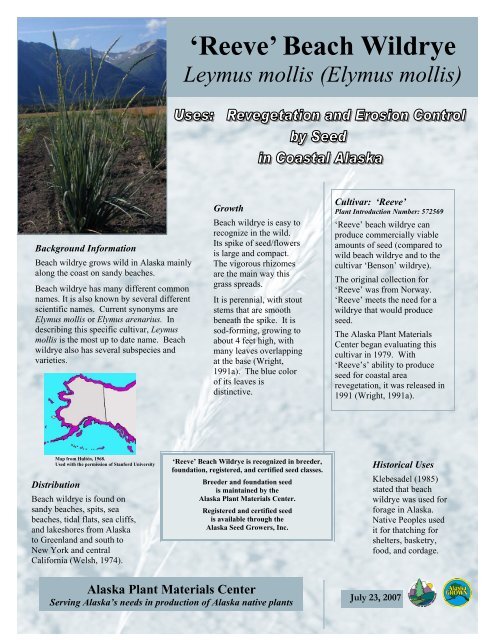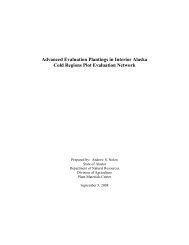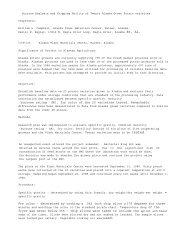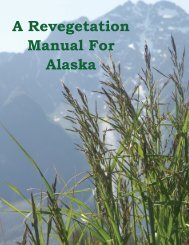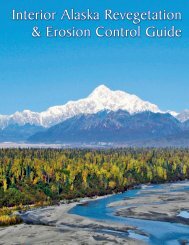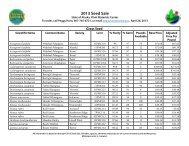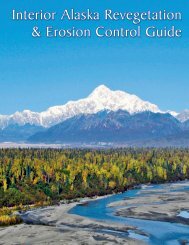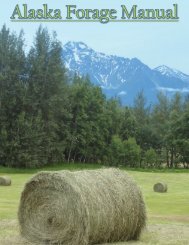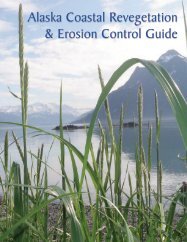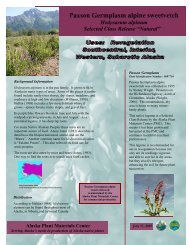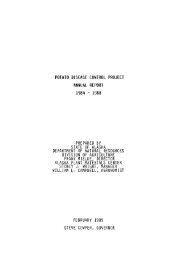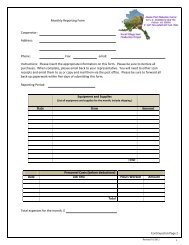'Reeve' Beach Wildrye - Alaska Plant Materials Center - State of ...
'Reeve' Beach Wildrye - Alaska Plant Materials Center - State of ...
'Reeve' Beach Wildrye - Alaska Plant Materials Center - State of ...
Create successful ePaper yourself
Turn your PDF publications into a flip-book with our unique Google optimized e-Paper software.
‘Reeve’ <strong>Beach</strong> <strong>Wildrye</strong><br />
Leymus mollis (Elymus mollis)<br />
Background Information<br />
<strong>Beach</strong> wildrye grows wild in <strong>Alaska</strong> mainly<br />
along the coast on sandy beaches.<br />
<strong>Beach</strong> wildrye has many different common<br />
names. It is also known by several different<br />
scientific names. Current synonyms are<br />
Elymus mollis or Elymus arenarius. In<br />
describing this specific cultivar, Leymus<br />
mollis is the most up to date name. <strong>Beach</strong><br />
wildrye also has several subspecies and<br />
varieties.<br />
Growth<br />
<strong>Beach</strong> wildrye is easy to<br />
recognize in the wild.<br />
Its spike <strong>of</strong> seed/flowers<br />
is large and compact.<br />
The vigorous rhizomes<br />
are the main way this<br />
grass spreads.<br />
It is perennial, with stout<br />
stems that are smooth<br />
beneath the spike. It is<br />
sod-forming, growing to<br />
about 4 feet high, with<br />
many leaves overlapping<br />
at the base (Wright,<br />
1991a). The blue color<br />
<strong>of</strong> its leaves is<br />
distinctive.<br />
Cultivar: ‘Reeve’<br />
<strong>Plant</strong> Introduction Number: 572569<br />
‘Reeve’ beach wildrye can<br />
produce commercially viable<br />
amounts <strong>of</strong> seed (compared to<br />
wild beach wildrye and to the<br />
cultivar ‘Benson’ wildrye).<br />
The original collection for<br />
‘Reeve’ was from Norway.<br />
‘Reeve’ meets the need for a<br />
wildrye that would produce<br />
seed.<br />
The <strong>Alaska</strong> <strong>Plant</strong> <strong>Materials</strong><br />
<strong>Center</strong> began evaluating this<br />
cultivar in 1979. With<br />
‘Reeve’s’ ability to produce<br />
seed for coastal area<br />
revegetation, it was released in<br />
1991 (Wright, 1991a).<br />
Map from Hultén, 1968.<br />
Used with the permission <strong>of</strong> Stanford University<br />
Distribution<br />
<strong>Beach</strong> wildrye is found on<br />
sandy beaches, spits, sea<br />
beaches, tidal flats, sea cliffs,<br />
and lakeshores from <strong>Alaska</strong><br />
to Greenland and south to<br />
New York and central<br />
California (Welsh, 1974).<br />
‘Reeve’ <strong>Beach</strong> <strong>Wildrye</strong> is recognized in breeder,<br />
foundation, registered, and certified seed classes.<br />
Breeder and foundation seed<br />
is maintained by the<br />
<strong>Alaska</strong> <strong>Plant</strong> <strong>Materials</strong> <strong>Center</strong>.<br />
Registered and certified seed<br />
is available through the<br />
<strong>Alaska</strong> Seed Growers, Inc.<br />
Historical Uses<br />
Klebesadel (1985)<br />
stated that beach<br />
wildrye was used for<br />
forage in <strong>Alaska</strong>.<br />
Native Peoples used<br />
it for thatching for<br />
shelters, basketry,<br />
food, and cordage.<br />
<strong>Alaska</strong> <strong>Plant</strong> <strong>Materials</strong> <strong>Center</strong><br />
Serving <strong>Alaska</strong>’s needs in production <strong>of</strong> <strong>Alaska</strong> native plants<br />
July 23, 2007
‘Reeve’ <strong>Beach</strong> <strong>Wildrye</strong><br />
‘Reeve’ <strong>Beach</strong> <strong>Wildrye</strong> for <strong>Alaska</strong> Revegetation Purposes<br />
<strong>Beach</strong> wildrye grows throughout the coasts <strong>of</strong> <strong>Alaska</strong>. Thus, for revegetation in sandy or<br />
gravelly places, it makes sense to use a species that might naturally occur. The native<br />
beach wildrye does not form viable seed. Use the cultivar ‘Reeve’ for places that need<br />
seed.<br />
‘Reeve’ provides good erosion control because <strong>of</strong> its aggressive rhizomes and roots. It<br />
can successfully revegetate areas unsuitable for other species. Prior planning is essential.<br />
‘Reeve’ Peculiarities<br />
<strong>Beach</strong> wildrye does poorly in organic, silt, or clay soils. It does not tolerate excessive<br />
foot traffic. It also does not compete well with other grasses (Wright, 1994).<br />
<strong>Plant</strong> by seed, not sprigs!<br />
‘Reeve’ beach wildrye seed<br />
~33,000 seeds per pound<br />
To Produce<br />
‘Reeve’ beach wildrye<br />
• ‘Reeve’ produces seed three years after<br />
the first planting.<br />
• ‘Reeve’ does not decline in production<br />
over time.<br />
• Poor seedling vigor occurs if there is<br />
not enough sand in the soil.<br />
• Weed control is important for beach<br />
wildrye seedlings to become large<br />
enough to out-compete weeds.<br />
• <strong>Beach</strong> wildrye responds well to high<br />
nitrogen fertilizers (Wright, 1994).<br />
Peggy Hunt & Stoney Wright<br />
<strong>State</strong> <strong>of</strong> <strong>Alaska</strong><br />
Department <strong>of</strong> Natural Resources<br />
Division <strong>of</strong> Agriculture<br />
<strong>Plant</strong> <strong>Materials</strong> <strong>Center</strong><br />
5310 S. Bodenburg Spur Rd.<br />
Palmer, AK 99645-9706<br />
Phone: (907) 745-4469<br />
‘Reeve’ beach wildrye production field at the<br />
<strong>Plant</strong> <strong>Materials</strong> <strong>Center</strong> in Palmer, <strong>Alaska</strong>.<br />
References<br />
‘Reeve’ beach wildrye<br />
is a beautiful<br />
landscape plant.<br />
With its distinctive blue<br />
coloration, ‘Reeve’ makes<br />
a barren, sandy, or<br />
gravelly place look<br />
beautiful. Its plumes are<br />
beige when ripe.<br />
‘Reeve’ will hold the soil<br />
in place for many years<br />
because <strong>of</strong> its spreading,<br />
tenacious rhizomes.<br />
Hultén, E. 1968. Flora <strong>of</strong> <strong>Alaska</strong> and Neighboring<br />
Territories. © by the Board <strong>of</strong> Trustees <strong>of</strong> the<br />
Leland Stanford Jr. University, Stanford University<br />
Press, Stanford.<br />
Klebesadel, L.J. 1985. <strong>Beach</strong> <strong>Wildrye</strong> Characteristics<br />
and uses <strong>of</strong> a Native <strong>Alaska</strong>n Grass <strong>of</strong> Uniquely<br />
Coastal Distribution. Agroborealis, 17: 31-38.<br />
Welsh, S.L. 1974. Anderson’s Flora <strong>of</strong> <strong>Alaska</strong> and<br />
Adjacent Parts <strong>of</strong> Canada. Brigham Young University<br />
Press, Provo, Utah.<br />
Wright, S.J. 1991a. Release Notice—‘Reeve’<br />
<strong>Beach</strong> <strong>Wildrye</strong>. <strong>State</strong> <strong>of</strong> <strong>Alaska</strong>, Division <strong>of</strong> Agriculture,<br />
<strong>Plant</strong> <strong>Materials</strong> <strong>Center</strong>.<br />
Wright, S.J. 1994. <strong>Beach</strong> <strong>Wildrye</strong> <strong>Plant</strong>ing Guide<br />
for <strong>Alaska</strong>. <strong>State</strong> <strong>of</strong> <strong>Alaska</strong>, Division <strong>of</strong> Agriculture,<br />
<strong>Plant</strong> <strong>Materials</strong> <strong>Center</strong>.


